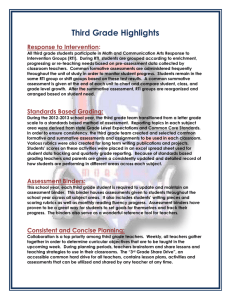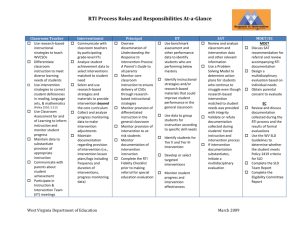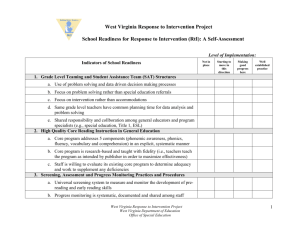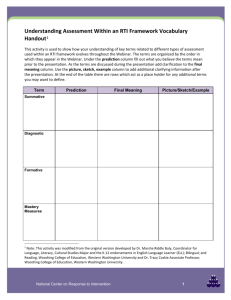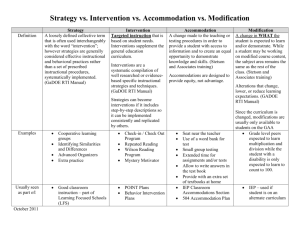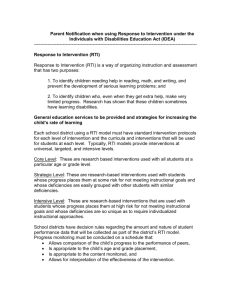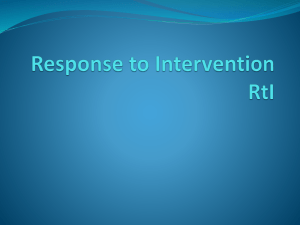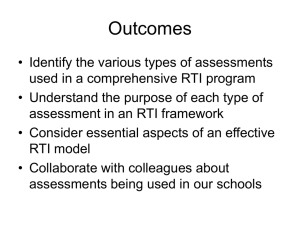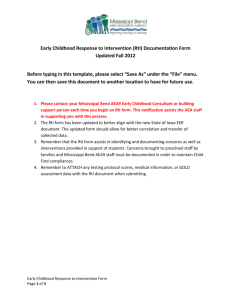RtI - High School District 214
advertisement
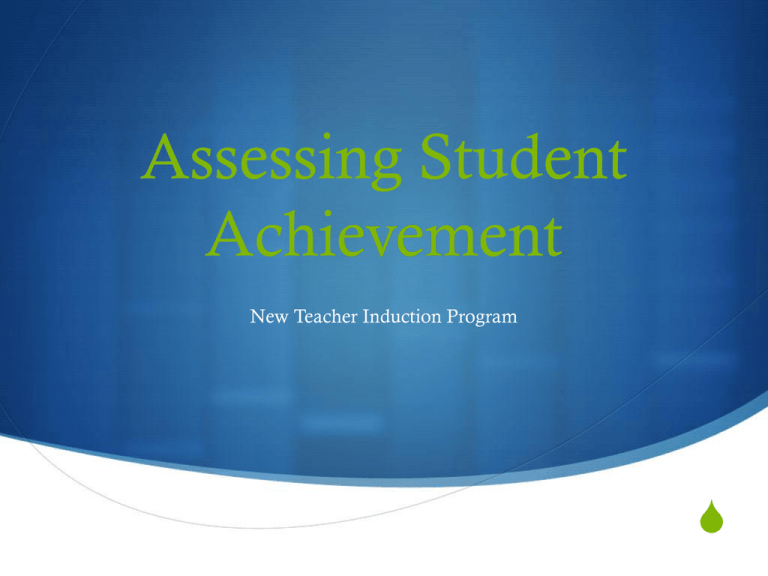
Assessing Student Achievement New Teacher Induction Program S Module Overview/Purpose S District 214 curricula address the three district goals and integrate the College Readiness Standards (CRS). S Student progress monitoring is achieved through the administration of standardized tests (EXPLORE/PLAN/ACT), as well as consistent use of formative and summative assessments in the classroom. Objectives: S After today’s session, participants will…. S become familiar with the three district goals. S understand the impact of CRS in their courses. S understand key concepts of formative and summative assessment. S understand key components of Response to Intervention (RtI). District Goals 1. Each No Child Left Behind sub-group's average Education Planning and Assessment System (EPAS) growth will surpass that of the previous cohort by 10% annually in reading, English, math, and science until growth from EXPLORE to ACT exceeds six points. 2. Increase student success rate (as measured by a grade of A, B, or C) per course by at least five percentile points each year until the threshold of 95% is attained. 3. The number of students enrolled in at least one AP course will increase over the previous year, as will the number of students taking at least one AP exam and the number of students earning a passing score on an AP exam, until at least 50% of all students have earned a score of three or higher on an AP exam. Implications for Teachers S EPAS (EXPLORE/PLAN/ACT): Emphasis on growth S Universal progress monitoring, used for placement and data-driven decision making for program-wide instructional interventions (RtI) S Student Success Rate: Working in PLTs teachers will implement research-based instructional practices and common formative and summative assessments in order to provide timely and targeted interventions to groups and individual students to promote student achievement (reduce the number of D’s and F’s). S AP Goal: Increase participation in AP courses, monitor student progress to promote diagonal movement, provide students with a rigorous and challenging curriculum, integrate AP skills at all levels College Readiness Standards S http://www.act.org/standards S College Readiness Standards are detailed, research-based descriptions of the skills and knowledge associated with what students are likely to know and be able to do based on their EXPLORE, PLAN, and/or ACT test scores. For each content area—English, mathematics, reading, and science— standards are provided for six score ranges along a scale common to EXPLORE (1–25), PLAN (1–32), and the ACT (1–36). Assessment for / of Learning S Assessment for Learning (formative assessment) S Used by teachers to make instructional decisions S Examples: written feedback, ungraded quizzes, exit slips S Assessment of Learning (summative assessment) S Used by teachers to evaluate student achievement S Examples: unit tests, semester exams, standardized tests Response to Intervention (RtI) S As of January 1, 2009, all school districts are required to have a District RtI Plan. S What is RtI ? S Response to Intervention integrates assessment and intervention within a multi-level prevention system to maximize student achievement and to reduce behavior problems. With RtI, schools identify students at risk for poor learning outcomes, monitor student progress, provide evidence-based interventions and adjust the intensity and nature of those interventions depending on a student’s responsiveness, and identify students with learning disabilities or other disabilities. Grading/Student Feedback S Grading is not the only way to give feedback to a student S Incorporate peer feedback and student self-assessment as often as possible S Rubrics provide guidelines and expectations for students and allow for consistent grading S Providing examples of strong and weak work allows students to see the connection between the criteria on the rubric and the finished product Standardized Testing S The ACT is administered at various times throughout the school year S In April of each year, all Juniors take the PSAE/ACT which is used to determine the percentage of students who meet/exceed state standards S Sophomores take the IACT test and Freshmen take the PLAN in preparation for the ACT Placement S Incoming freshmen are placed according to their scores on the EXPLORE test as well as teacher recommendations S Sometimes students are misplaced and a level change is necessary S Level changes are initiated by the classroom teacher and require parental approval Building-Specific Info. Questions/Comments S What questions do you have about the information presented today? S Is there a topic that you feel you need more information on? S Do you have any specific concerns at this time?
